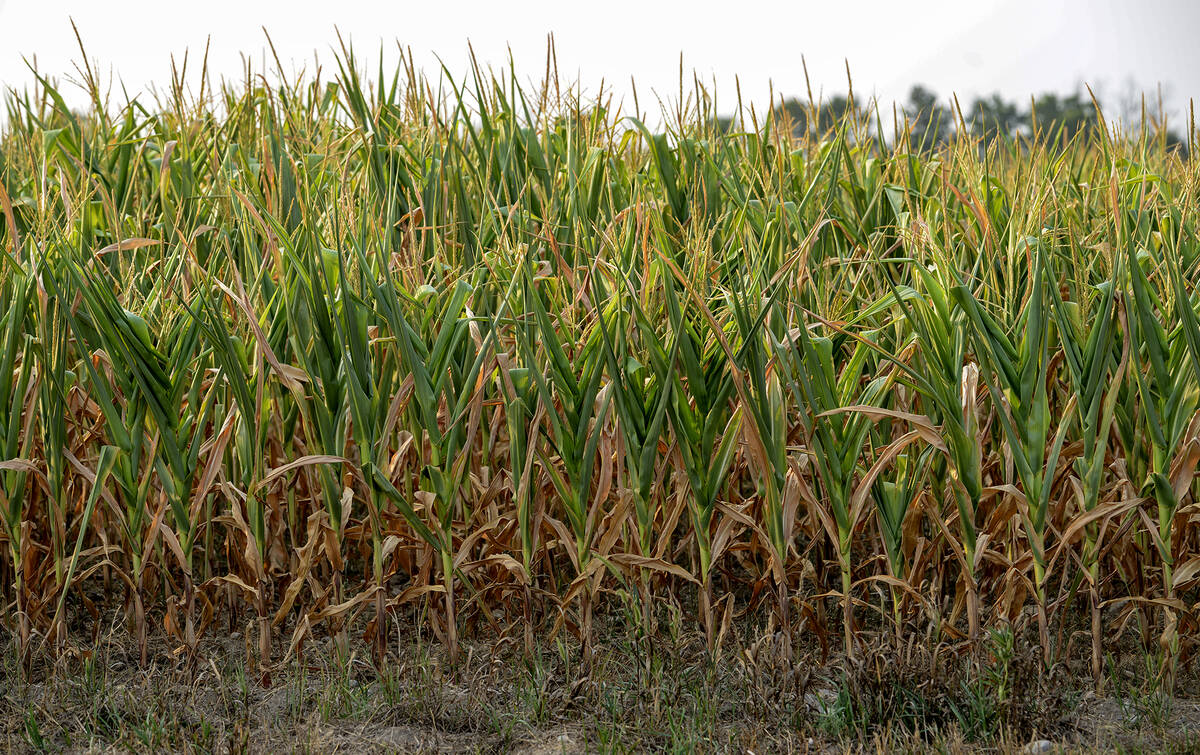As of Oct. 18, we estimate the Ontario soybean harvest was 40 per cent complete and corn progress stood at 30 per cent. Cooler temperatures delayed row crop harvest by 10 to 15 days. Harvest may stretch into November, as the latter half of October saw intermittent rains and cooler temperatures across the province. Yield reports confirm our production forecasts. We believe corn and soybean markets are in the process of making seasonal lows.
Quick look
Soybeans: Prices are holding firm as export demand has offset the surge in farmer selling.
Corn: Our production estimate of 10.1-10.2 million tonnes is being confirmed by yield reports.
Wheat: The quality of Ontario’s winter wheat crop is better than expected.
The Ontario markets are functioning to encourage demand. Basis levels are under pressure as farmers have been active sellers through harvest. Ontario wheat prices have come off lows and we anticipate higher prices in November. Demand from Quebec has been supportive for Ontario wheat prices.
Read Also

Extreme variability marks Ontario’s 2025 corn crop
The yield potential of Ontario’s 2025 corn crop was lost in some areas due to extreme dry conditions.
As of Oct. 15, U.S. farmers had harvested 62 per cent of the soybeans and 45 per cent of the corn. The row crop markets are absorbing harvest selling pressure. However, export demand has increased for U.S. corn and soybeans, which has stabilized prices. Biofuel demand is also larger than earlier anticipated.
The USDA trimmed its corn and soybean yield estimates on the October World Agriculture Supply and Demand Estimates (WASDE). Lower U.S. production is supportive longer-term for the corn and soybean markets.
As of mid-October, Brazilian farmers had planted 20 per cent of the soybeans and 45 per cent of the first corn crop. Argentine farmers had planted 16 per cent of the corn crop but there was minimal progress in soybeans.
Crude oil prices appear to be incorporating a risk premium due to unrest in the Middle East. This has underpinned the corn and soybean markets due to the biofuel component. The Canadian dollar continues to trade near seven month lows as the resource-based currency struggles from softer global growth.
Agriculture commodities have no risk premium due to geopolitical unrest. Uncertainty in Russia/Ukraine, China/Taiwan and ongoing tensions in the Middle East could spur a major rally in grain and oilseed markets later in the crop year. History tells us the longer wars drag on, the more evil and destructive they become.
Soybeans
Yield reports confirm our crop estimate of 4.2-4.3 million tonnes. This is up from last year’s crop of four million tonnes and up from the five-year average of four million tonnes. Farmer selling is coming in as expected. Producer deliveries are at seasonal highs during October and November. However, we’ve seen a minor increase in prices over the past couple of weeks as export demand steps forward.
At the same time, domestic crushers have kept their bids in line with the export market. The increase in domestic and export demand has offset the surge in farmer selling, resulting in firmer prices.
At the time of writing this article, Brazilian soybeans were offered at US$486/tonne f.o.b. Paranagua, down $16/tonne from two weeks earlier. U.S. soybeans were quoted at $504/tonne f.o.b. the Gulf, down $9/tonne from 14 days ago. Ontario soybeans were quoted at US$475/tonne f.o.b. St Lawrence port. The competitiveness of Ontario soybeans is enhancing export demand.
On the October WASDE report, the USDA trimmed its soybean yield estimate from 50.1 bu./acre to 49.6 bu./acre. Production is now expected to finish near 111.7 million tonnes, down from last year’s output of 116.2 million tonnes and down from the five-year average of 113.8 million tonnes.
U.S. export sales are down 31 per cent from last year. Given the smaller crop, the market is rationing demand by trading above Brazilian origin. The exportable surplus from Brazil is dwindling and this overall environment should result in higher world values latter in November and December.
Planting progress in South America is in the early stages. The USDA had upcoming Brazilian output at 163 million tonnes, up from the previous crop size of 156 million tonnes. Argentine output was estimated at 48 million tonnes, up from 25 million tonnes harvested this spring. The main Brazilian harvest occurs in February and the Argentine crop comes off in April. Ontario farmers have some time to wait before the larger South American crops come on the world market.
What to do: We believe the soybean market is making seasonal lows. We’ve advised farmers to be 20 per cent sold on their 2023 production. We’re planning to make our next sale in the following issue. The market will have breathing room to move higher after the North American harvest pressure ends and the Brazil’s exportable surplus declines.
Corn
Big crops tend to get bigger as harvest progresses. Yield reports confirm our production estimate of 10.1-10.2 million tonnes. This is up from last year’s output of 9.4 million tonnes and up from the five-year average of 9.2 million tonnes. Farmer selling has been larger than anticipated due to historically high yields. Ontario farmers tend to sell 50-55 per cent of the production by Dec. 31.
Due to the larger crop, the commercial pipeline needs to absorb about 5.3 million tonnes this fall, compared to 4.6 million tonnes last year. The market needs to encourage export demand as domestic usage in the first four months of the crop year is only 2.7 million tonnes.
At the time of writing this article, Brazilian corn was quoted at US$224/tonne f.o.b. Paranagua, down $2/tonne from two weeks earlier. U.S. No.2 corn for November loading was quoted at $227/tonne f.o.b. the Gulf, down $27/tonne from our previous issue. French corn was quoted at $212/tonne f.o.b. La Pallice. Ontario corn was valued at US$210/tonne f.o.b. St Lawrence port.
In my previous article, we were estimating Ontario corn exports from Sept. 1 through Dec. 31 at 500,00 tonnes. Ontario corn exports need to reach about 800,000 in this window or we’ll see additional pressure on the domestic market. Europe is the main destination for Ontario corn exports.
Weakness in the European feed complex is setting a negative tone for the Ontario export potential. Ukraine wheat and corn are flowing through neighboring countries to reach export markets. The spillover effect is that it pressures domestic Eastern European values. This distortion in normal trade flow has contributed to lower export demand for Ontario corn.
On top of this, Poland’s corn crop will likely reach 9.3 million tonnes, up one million tonnes from last year. On the opposite side of the European continent, French corn production will likely finish near 11.5 million tonnes, up from the year-ago output of 10.8 million tonnes. European wheat exports are lagging year ago levels due to strong competition from Russia. This is pushing more European wheat into feed channels.
There are no significant changes to other major exporters. The USDA had U.S. corn production at 382.6 million tonnes, up from last year’s crop size of 349 million tonnes and up from the five-year average of 365 million tonnes. Brazilian corn production estimates range from 118-130 million tonnes, down from this previous crop of 137 million tonnes. Early estimates have Argentinean output at 55 million tonnes, up from 34 million tonnes harvesting this past spring.
South American crops are in the early planting stages. The bulk of exportable surplus from Brazil will only be harvested during May and June 2024. Ontario farmers have a significant amount of time before South American harvest pressure occurs.
What to do: We’ve advised Ontario farmers to be 20 per cent sold on their 2023 production. We’re planning on making our second incremental sale in the next issue after the U.S. harvest. Later in fall, the market has potential to incorporate a risk premium due to uncertainty in South American production.
Wheat
Ontario produced 2.6 million tonnes of wheat this year, up from the 2022 output of 2.2 million tonnes and up from the five-year average of 2.1 million tonnes. Our contacts in Ontario have corrected us, saying there is only 400,000 tonnes of feed quality wheat, instead of our projection of one million tonnes. The wheat crop was higher quality than we expected. Secondly, approximately 500,000 tonnes of Ontario wheat will trade into Quebec this year.
We continue to estimate that one million tonnes will be used for domestic milling purposes and about 600,000 tonnes will be fed domestically. The remainder will have to move offshore. Farmers generally sell 80 per cent of the crop between Aug. 1 and Dec. 31. We’re projecting that farmers will sell 2.1 million tonnes this fall, up from 1.8 million tonnes during the same period of 2022. The commercial pipeline is full, especially with the larger corn and soybean crops.
During the third week of October, French soft wheat was offered at US$247/tonne f.o.b. Rouen. U.S. No.2 soft red winter wheat was quoted at $252/tonne f.o.b. the Gulf. Ontario soft red winter wheat was quoted at US$235/tonne f.o.b. St. Lawrence port.
During August and September, the U.S. soft red winter wheat market was lacking demand. Values were based on U.S. domestic milling interest. However, we’re now seeing larger export sales for U.S. wheat.
More notably, China has also been a significant buyer of U.S. soft red winter. This confirms our ideas that the Chinese crop quality was downgraded due to excessive rains. Additional demand is also surfacing from other major destinations such as Central America and the Caribbean. Apparently, export demand is also stepping forward for Ontario soft red winter, which has potential to lift prices later in fall.
Russia has been exporting wheat at a rapid pace over the past couple of months. Ideas are that approximately 40 per cent of the Russian wheat crop was downgraded due to rains at harvest. Russia’s export pace is expected to slow in the latter half of the crop year. Argentina and Australia continue to contend with drier conditions. This will result in larger than expected demand from Southeast Asia for North American wheat.
There is no risk premium in the wheat market due to the Russian war on Ukraine. If anything, the war has contributed to the lower price structure as Ukraine wheat flows through alternative European ports to reach export markets. This weakens the European wheat market, causing pressure on world prices.
At some point in the crop year, the wheat market will go through a structural market change. We believe there will be a transition to European and North American wheat due to adverse conditions in Black Sea region.
What to do: The soft red winter wheat market has rallied 40 cents/bu. off recent lows. This week, we’re advising producers to start sales by selling 15 to 20 per cent of their production. The futures market spread is trading near full carry. The market is telling producers to sell now for delivery in the deferred positions. In the previous issues, we’ve encouraged producers with feed wheat to sell 20-30 per cent of their feed quality product.













